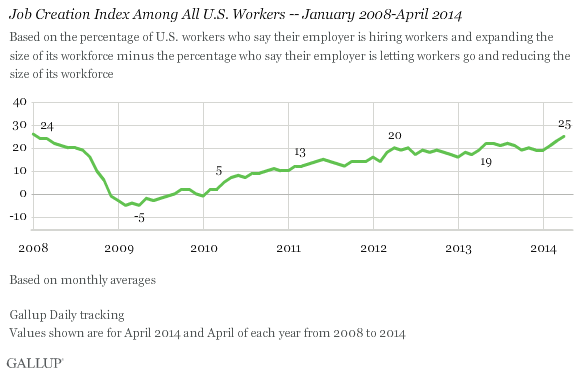WASHINGTON, D.C. -- Gallup's U.S. Job Creation Index continued to climb to +25 in April from +23 in March. The index in April is one point shy of the all-time high found in January 2008, the first month Gallup began tracking hiring daily. The index is based on employee reports of hiring and layoffs at their workplaces.

The U.S. Job Creation Index had a strong start in early 2008, but it began to fall later that year as the economy plunged into a recession. The index fell to a record low of -5 in both February and April 2009. Since then, the index has slowly recovered and registered averages in the low twenties starting in early 2012. It hovered in the high teens and low twenties through 2012 and 2013 before steadily rising in 2014.
The results for April are based on interviews with more than 16,000 full- and part-time workers. The index score of +25 reflects 39% of employees nationwide saying their employers are hiring workers and expanding the size of its workforce and 14% of employees saying their employers are letting workers go and reducing the size of their workforce. The percentage of employees who report their employers are letting workers go is the lowest Gallup has recorded, tied with 14% measured in January 2008. A remaining 41% of U.S. workers in April say their company is not changing the size of its workforce.

Nongovernment Job Creation Reaches New High
Nongovernment job creation increased to +28 in April from +26 in March and is the highest Gallup has recorded since it began asking about government vs. nongovernment work in August 2008. Government job creation -- based on reports from those who identify their place of employment as local, state, or federal government -- was +12, similar to the +13 recorded the last two months. Since 2010, nongovernment workers have reported a more positive hiring situation than government workers have.

Within the government employment sector, the job creation situation remains most positive at the state level (+20) followed by the local level (+13). The federal government trails behind both, with an index of -1.This score indicates that the federal government is basically at a standstill in terms of net hiring.
The overall U.S. Job Creation Index is primarily driven by nongovernment workers' perceptions of the hiring situation in their workplaces because more workers are employed in the nongovernment sector than in the government employment sector. Nongovernment net hiring tends to rise early in the year -- as has been the case in 2014 -- but then generally levels off or drops slightly later in the year.
Implications
The recent rise in employee reports of hiring is a positive sign that the economic slowdown may be ending. More companies may be doing better than in recent years and thus are looking to increase the size of their workforces. Gallup's measure of the U.S. Payroll to Population employment rate was also up slightly in April, which supports the rise in job creation, but the first quarter average in 2014 is down somewhat from the first quarter average in 2013. The current U.S. Job Creation Index signals that roughly the same percentage of employers are hiring new workers and increasing their staff now as they were in early 2008 before the recession took hold and before the stock market crash later that year.
Gallup.com reports results from these indexes in daily, weekly, and monthly averages and in Gallup.com stories. Complete trend data are always available to view and export in the following charts:
Daily: Employment, Economic Confidence, Job Creation, Consumer Spending
Weekly: Employment, Economic Confidence, Job Creation, Consumer Spending
Read more about Gallup's economic measures.
View our economic release schedule.
Survey Methods
Results for this Gallup poll are based on telephone interviews conducted April 1-30, 2014, on the Gallup Daily tracking survey, with a random sample of 16,641 employed adults, aged 18 and older, living in all 50 U.S. states and the District of Columbia.
For results based on the total sample of workers, the margin of sampling error is ±1 percentage point at the 95% confidence level.
Interviews are conducted with respondents on landline telephones and cellular phones, with interviews conducted in Spanish for respondents who are primarily Spanish-speaking. Each sample of national adults includes a minimum quota of 50% cellphone respondents and 50% landline respondents, with additional minimum quotas by time zone within region. Landline and cellular telephone numbers are selected using random-digit-dial methods. Landline respondents are chosen at random within each household on the basis of which member had the most recent birthday.
Samples are weighted to correct for unequal selection probability, nonresponse, and double coverage of landline and cell users in the two sampling frames. They are also weighted to match the national demographics of gender, age, race, Hispanic ethnicity, education, region, population density, and phone status (cellphone only/landline only/both, and cellphone mostly). Demographic weighting targets are based on the most recent Current Population Survey figures for the aged 18 and older U.S. population. Phone status targets are based on the most recent National Health Interview Survey. Population density targets are based on the most recent U.S. census. All reported margins of sampling error include the computed design effects for weighting.
In addition to sampling error, question wording and practical difficulties in conducting surveys can introduce error or bias into the findings of public opinion polls.
For more details on Gallup's polling methodology, visit www.gallup.com.
